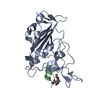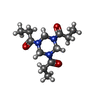[English] 日本語
 Yorodumi
Yorodumi- PDB-8aaa: Crystal structure of SARS-CoV-2 S RBD in complex with a stapled p... -
+ Open data
Open data
- Basic information
Basic information
| Entry | Database: PDB / ID: 8aaa | ||||||
|---|---|---|---|---|---|---|---|
| Title | Crystal structure of SARS-CoV-2 S RBD in complex with a stapled peptide | ||||||
 Components Components |
| ||||||
 Keywords Keywords | VIRAL PROTEIN / sRBD / Stapled peptide | ||||||
| Function / homology |  Function and homology information Function and homology informationsymbiont-mediated disruption of host tissue / Maturation of spike protein / Translation of Structural Proteins / Virion Assembly and Release / host cell surface / host extracellular space / viral translation / symbiont-mediated-mediated suppression of host tetherin activity / Induction of Cell-Cell Fusion / structural constituent of virion ...symbiont-mediated disruption of host tissue / Maturation of spike protein / Translation of Structural Proteins / Virion Assembly and Release / host cell surface / host extracellular space / viral translation / symbiont-mediated-mediated suppression of host tetherin activity / Induction of Cell-Cell Fusion / structural constituent of virion / membrane fusion / entry receptor-mediated virion attachment to host cell / Attachment and Entry / host cell endoplasmic reticulum-Golgi intermediate compartment membrane / positive regulation of viral entry into host cell / receptor-mediated virion attachment to host cell / host cell surface receptor binding / symbiont-mediated suppression of host innate immune response / receptor ligand activity / endocytosis involved in viral entry into host cell / fusion of virus membrane with host plasma membrane / fusion of virus membrane with host endosome membrane / viral envelope / symbiont entry into host cell / virion attachment to host cell / SARS-CoV-2 activates/modulates innate and adaptive immune responses / host cell plasma membrane / virion membrane / identical protein binding / membrane / plasma membrane Similarity search - Function | ||||||
| Biological species |  synthetic construct (others) | ||||||
| Method |  X-RAY DIFFRACTION / X-RAY DIFFRACTION /  SYNCHROTRON / SYNCHROTRON /  MOLECULAR REPLACEMENT / Resolution: 1.9 Å MOLECULAR REPLACEMENT / Resolution: 1.9 Å | ||||||
 Authors Authors | Brear, P. / Chen, L. / Gaynor, K. / Harman, M. / Dods, R. / Hyvonen, M. | ||||||
| Funding support | 1items
| ||||||
 Citation Citation |  Journal: Nat Commun / Year: 2023 Journal: Nat Commun / Year: 2023Title: Multivalent bicyclic peptides are an effective antiviral modality that can potently inhibit SARS-CoV-2. Authors: Gaynor, K.U. / Vaysburd, M. / Harman, M.A.J. / Albecka, A. / Jeffrey, P. / Beswick, P. / Papa, G. / Chen, L. / Mallery, D. / McGuinness, B. / Van Rietschoten, K. / Stanway, S. / Brear, P. / ...Authors: Gaynor, K.U. / Vaysburd, M. / Harman, M.A.J. / Albecka, A. / Jeffrey, P. / Beswick, P. / Papa, G. / Chen, L. / Mallery, D. / McGuinness, B. / Van Rietschoten, K. / Stanway, S. / Brear, P. / Lulla, A. / Ciazynska, K. / Chang, V.T. / Sharp, J. / Neary, M. / Box, H. / Herriott, J. / Kijak, E. / Tatham, L. / Bentley, E.G. / Sharma, P. / Kirby, A. / Han, X. / Stewart, J.P. / Owen, A. / Briggs, J.A.G. / Hyvonen, M. / Skynner, M.J. / James, L.C. | ||||||
| History |
|
- Structure visualization
Structure visualization
| Structure viewer | Molecule:  Molmil Molmil Jmol/JSmol Jmol/JSmol |
|---|
- Downloads & links
Downloads & links
- Download
Download
| PDBx/mmCIF format |  8aaa.cif.gz 8aaa.cif.gz | 60.3 KB | Display |  PDBx/mmCIF format PDBx/mmCIF format |
|---|---|---|---|---|
| PDB format |  pdb8aaa.ent.gz pdb8aaa.ent.gz | 41.6 KB | Display |  PDB format PDB format |
| PDBx/mmJSON format |  8aaa.json.gz 8aaa.json.gz | Tree view |  PDBx/mmJSON format PDBx/mmJSON format | |
| Others |  Other downloads Other downloads |
-Validation report
| Summary document |  8aaa_validation.pdf.gz 8aaa_validation.pdf.gz | 805.1 KB | Display |  wwPDB validaton report wwPDB validaton report |
|---|---|---|---|---|
| Full document |  8aaa_full_validation.pdf.gz 8aaa_full_validation.pdf.gz | 806.3 KB | Display | |
| Data in XML |  8aaa_validation.xml.gz 8aaa_validation.xml.gz | 11 KB | Display | |
| Data in CIF |  8aaa_validation.cif.gz 8aaa_validation.cif.gz | 15 KB | Display | |
| Arichive directory |  https://data.pdbj.org/pub/pdb/validation_reports/aa/8aaa https://data.pdbj.org/pub/pdb/validation_reports/aa/8aaa ftp://data.pdbj.org/pub/pdb/validation_reports/aa/8aaa ftp://data.pdbj.org/pub/pdb/validation_reports/aa/8aaa | HTTPS FTP |
-Related structure data
| Related structure data |  7z8oC  7cjfS S: Starting model for refinement C: citing same article ( |
|---|---|
| Similar structure data | Similarity search - Function & homology  F&H Search F&H Search |
- Links
Links
- Assembly
Assembly
| Deposited unit | 
| ||||||||
|---|---|---|---|---|---|---|---|---|---|
| 1 |
| ||||||||
| Unit cell |
| ||||||||
| Components on special symmetry positions |
|
- Components
Components
| #1: Protein | Mass: 22074.678 Da / Num. of mol.: 1 Source method: isolated from a genetically manipulated source Source: (gene. exp.)  Gene: S, 2 / Production host:  |
|---|---|
| #2: Protein/peptide | Mass: 1762.216 Da / Num. of mol.: 1 / Source method: obtained synthetically / Source: (synth.) synthetic construct (others) |
| #3: Chemical | ChemComp-29N / |
| #4: Water | ChemComp-HOH / |
| Has ligand of interest | Y |
| Has protein modification | Y |
-Experimental details
-Experiment
| Experiment | Method:  X-RAY DIFFRACTION / Number of used crystals: 1 X-RAY DIFFRACTION / Number of used crystals: 1 |
|---|
- Sample preparation
Sample preparation
| Crystal | Density Matthews: 2.88 Å3/Da / Density % sol: 57.34 % |
|---|---|
| Crystal grow | Temperature: 294 K / Method: vapor diffusion, sitting drop Details: 22% PEGSM, 2% Glycerol, 0.01M CoCl2, 0.2M MgCl2, 0.1M Bis TRIS PH range: 8 / Temp details: l |
-Data collection
| Diffraction | Mean temperature: 100 K / Serial crystal experiment: Y | ||||||||||||||||||||||||||||||
|---|---|---|---|---|---|---|---|---|---|---|---|---|---|---|---|---|---|---|---|---|---|---|---|---|---|---|---|---|---|---|---|
| Diffraction source | Source:  SYNCHROTRON / Site: SYNCHROTRON / Site:  Diamond Diamond  / Beamline: I04 / Wavelength: 0.9795 Å / Beamline: I04 / Wavelength: 0.9795 Å | ||||||||||||||||||||||||||||||
| Detector | Type: DECTRIS EIGER2 XE 16M / Detector: PIXEL / Date: May 13, 2021 | ||||||||||||||||||||||||||||||
| Radiation | Protocol: SINGLE WAVELENGTH / Monochromatic (M) / Laue (L): M / Scattering type: x-ray | ||||||||||||||||||||||||||||||
| Radiation wavelength | Wavelength: 0.9795 Å / Relative weight: 1 | ||||||||||||||||||||||||||||||
| Reflection | Resolution: 1.848→97.168 Å / Num. obs: 13749 / % possible obs: 91.5 % / Redundancy: 19.4 % / CC1/2: 0.996 / Rmerge(I) obs: 0.247 / Rpim(I) all: 0.058 / Rrim(I) all: 0.254 / Net I/σ(I): 9.3 / Num. measured all: 266723 | ||||||||||||||||||||||||||||||
| Reflection shell | Diffraction-ID: 1
| ||||||||||||||||||||||||||||||
| Serial crystallography sample delivery | Method: fixed target |
- Processing
Processing
| Software |
| ||||||||||||||||||||||||||||||||||||||||||||||||||||||||||||||||||
|---|---|---|---|---|---|---|---|---|---|---|---|---|---|---|---|---|---|---|---|---|---|---|---|---|---|---|---|---|---|---|---|---|---|---|---|---|---|---|---|---|---|---|---|---|---|---|---|---|---|---|---|---|---|---|---|---|---|---|---|---|---|---|---|---|---|---|---|
| Refinement | Method to determine structure:  MOLECULAR REPLACEMENT MOLECULAR REPLACEMENTStarting model: 7CJF Resolution: 1.9→48.58 Å / Cor.coef. Fo:Fc: 0.954 / Cor.coef. Fo:Fc free: 0.952 / SU R Cruickshank DPI: 0.179 / Cross valid method: THROUGHOUT / SU R Blow DPI: 0.183 / SU Rfree Blow DPI: 0.146 / SU Rfree Cruickshank DPI: 0.145
| ||||||||||||||||||||||||||||||||||||||||||||||||||||||||||||||||||
| Displacement parameters | Biso mean: 51.27 Å2
| ||||||||||||||||||||||||||||||||||||||||||||||||||||||||||||||||||
| Refine analyze | Luzzati coordinate error obs: 0.31 Å | ||||||||||||||||||||||||||||||||||||||||||||||||||||||||||||||||||
| Refinement step | Cycle: LAST / Resolution: 1.9→48.58 Å
| ||||||||||||||||||||||||||||||||||||||||||||||||||||||||||||||||||
| Refine LS restraints |
| ||||||||||||||||||||||||||||||||||||||||||||||||||||||||||||||||||
| LS refinement shell | Resolution: 1.9→1.94 Å
|
 Movie
Movie Controller
Controller


 PDBj
PDBj






